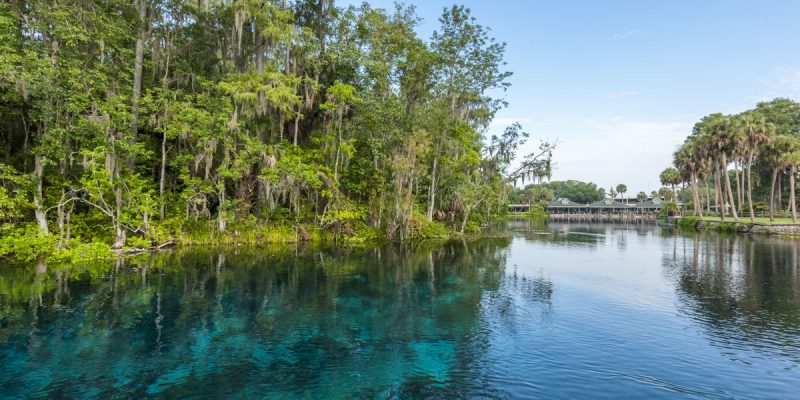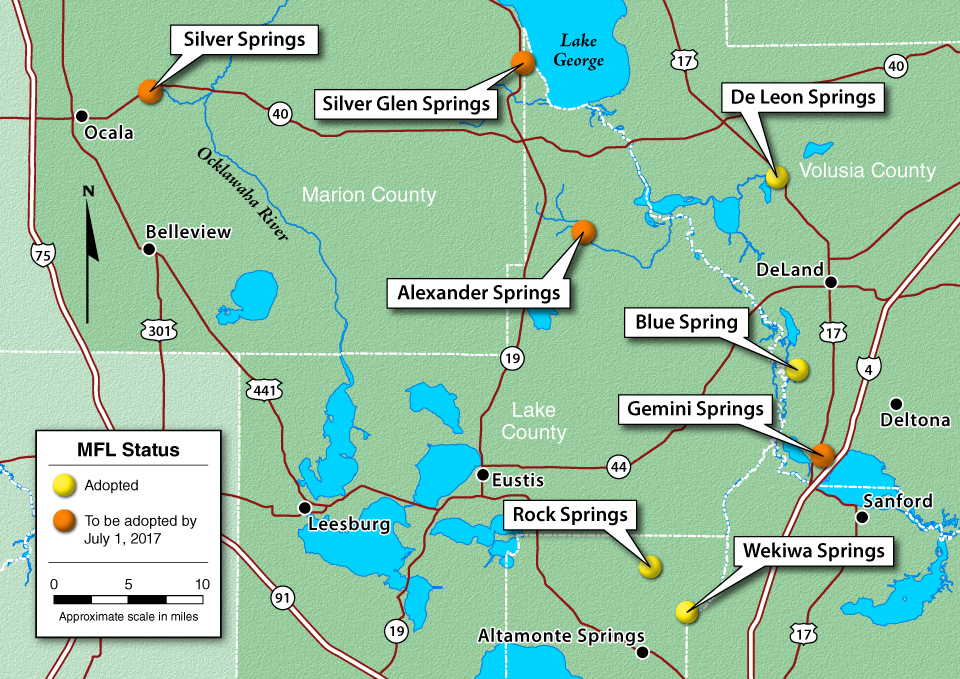
Silver Springs is a first-magnitude spring located in Marion County. The springs and the associated Silver River are popular recreation destinations enjoyed by thousands of visitors each year. In 1987 Silver Springs and Silver River were designated Outstanding Florida Waters (OFWs) for their many exceptional natural attributes and in 2016 the spring was designated as an Outstanding Florida Springs (OFS).
The St. Johns River Water Management District established minimum flows and levels (MFLs) for Silver Springs, a first-magnitude spring in Marion County and one of several Outstanding Florida Springs (OFS).
These priority OFS springs were required by state law to have MFLs in place by July 1, 2017. MFLs set the limit of available water beyond which further water withdrawals would be significantly harmful to a waterbody.
Historically, Silver Springs was the largest inland spring in the state by discharge, with a mean annual flow of 820 cfs, and is the second largest spring in Florida overall. The Silver Springs system has experienced a decline in flow of approximately 32 percent since the 1930s due to long-term rainfall deficit, flow suppression related to increases in submersed aquatic vegetation (SAV) downstream in Silver River, and, to a lesser degree, regional groundwater pumping.
Specifically, a 112-inch rainfall deficit from the 1970s to approximately 2000, and average rainfall since 2000 has caused approximately a 13.3 percent flow decline. Flow suppression due to increased SAV downstream in the river has resulted in approximately a 15.5 percent flow decline. Groundwater withdrawals/pumping has caused approximately a 3.5 percent flow decline.
Three minimum flows for Silver Springs were recommended, based on criteria developed from vegetation, soils and topography data. The MFLs will protect the structure and function of wetlands and aquatic habitats, as well as other ecological functions and values.
Currently, all three MFLs for Silver Springs are being achieved. However, the Silver Springs MFLs are projected to not be met by 2025 and so a prevention strategy is necessary.
In addition to setting MFLs, the District continues to collaborate with local governments on several constructed and future projects that will promote sustainability of water resources in the Silver Springs basin. These projects include:
- Water conservation measures;
- The expansion of reclaimed water networks for landscape irrigation;
- The design of a treatment wetlands that utilizes treated wastewater; and the capturing of stormwater runoff to enhance aquifer recharge; and
- The development of alternative water supply (AWS) from the Lower Floridan aquifer.
The MFLs, adopted by rule in April 2017, will be evaluated within 10 years since scientific understanding of the system will continue to improve. Furthermore, to monitor the status of an adopted MFL, a screening level analysis will be performed approximately every five years, as well as when permit applications are considered that may impact the MFL.
The MFLs became effective June 27, 2017, after adoption by the District Governing Board’s April 11, 2017, public meeting.
The Silver Springs MFLs determination was adopted and became effective in 2017. The final MFLs report is available here.
Key dates:
- March 9 Draft Silver Springs MFL report and Prevention Strategy available online
- March 16 Public workshop in Ocala
- March 16–30 Stakeholder comment period
- April 11 Governing Board meeting (to be held in Eustis)
- July 1 Statutory deadline for Outstanding Florida Spring MFLs
By the numbers
- The proposed minimum flow protects 94 percent of Silver Springs’ natural flow.
- The proposed minimum flow allows a 6 percent impact from water withdrawals.
- Current groundwater withdrawals in the Silver Springs’ system reduce the natural flow approximately 3.5 percent. This leaves about 2.5 percent of additional reduction from groundwater withdrawals.


